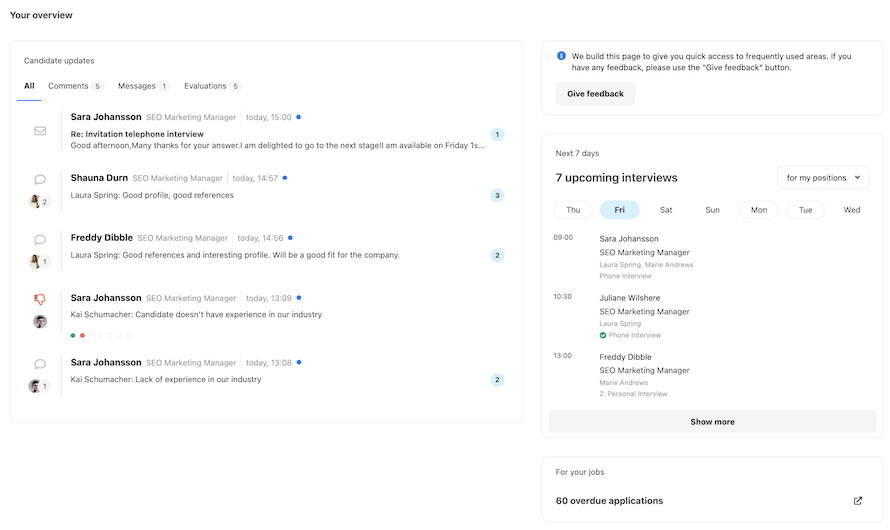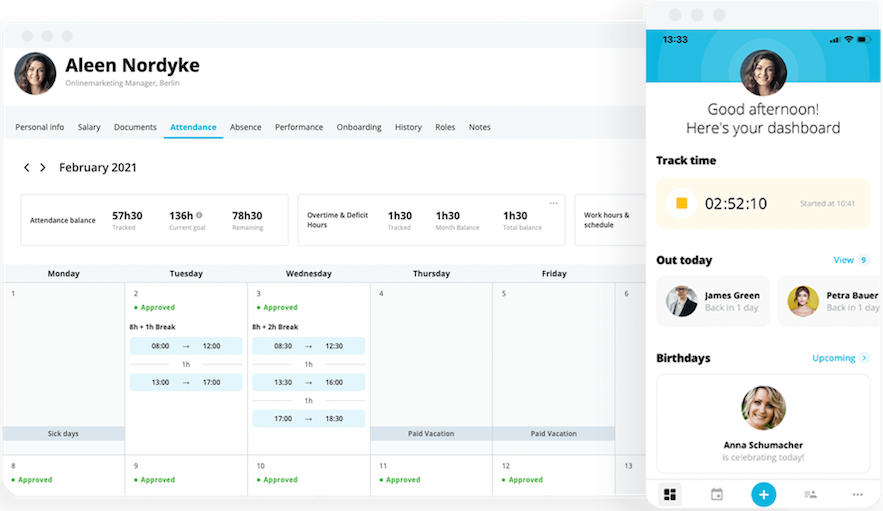
Optimise recruitment workflows
Optimise your recruitment workflow with Personio's powerful recruitment software.
Explore our productWhat Is Proactive Recruiting?

When hiring managers are faced with a vacant position, they're usually at the mercy of the job market. But by taking a proactive approach to recruitment, you can build a more controlled, strategic, and effective hiring process—and better candidate outcomes. Here’s how.
Advertise jobs on 600+ portals – see how it’s done with PersonioWhat Is Proactive Recruiting?
Proactive recruiting is the process of sourcing, engaging and attracting job candidates before you need them. Through proactive recruiting, you build a talent pool of prospects that you can draw from to fill an open role.
The numbers back up the practice: A recent survey found that 73% of potential candidates are passive job seekers, meaning they’re open to opportunities but aren’t actively seeking out or applying to roles.
To tap into that unclaimed candidate market—and get ahead of hiring demand—you need to be proactively recruiting.
Much like marketing, proactive recruitment follows a funnel-style design:
Step 1 – Identify potential hires.
Step 2 – Connect and engage with them online or in person.
Step 3 – Nurture relationships with them.
Step 4 – Attract them to your company and/or job vacancies.
Step 5 – Convert them into candidates when the time is right.
Proactive Recruiting vs Reactive Recruiting
Proactive recruitment is the opposite of the more traditional reactive recruitment method.
Reactive recruitment is when you start the recruiting process after a role is made vacant. In this scenario, there’s more pressure on the hiring manager to find the best talent quickly so the team isn’t hit with organisational stress, lost income, and decreased productivity.
But with proactive recruiting, you attract talent and then fill the role when it opens up, staying ahead of your hiring needs.
The Top Benefits of Proactive Recruiting
While some talent acquisition strategies—like reactive hiring—focus on the short-term, proactive recruiting focuses on the long-term. With this forward-thinking recruiting method, you can…
1. Create A Better Candidate Experience
Proactive recruiting is a relationship-driven approach to hiring. Through connections and conversations, you build trust and transparency with potential candidates over time, in turn, getting them excited about the company before they even apply.
This nurturing element builds a better candidate experience since prospects can be more honest about what they’re looking for in a role and why the role/company is or isn’t a good fit. These insights can then inform your hiring process or help your organisation address any weaknesses.
For example, you may discover that prospects want more remote work flexibility, customised benefits packages, or more transparency on the company’s ethical values. Then, you can use that feedback to improve your positioning.
Source the best talent around

Design career pages, create job ads and publish them on more than 600 portals with just one click. Say hello to seamless recruitment with Personio.
Find the Talent You Need2. Get Ahead Of Hiring Needs
Having to fill a job vacancy is stressful, especially when it’s unexpected. By taking a proactive recruiting approach, you have better control over your recruitment and hiring process and aren’t bound to the unstable job market.
Instead of simply hoping you’ll fill a role successfully, you’ll already have a pool of talented prospects to recruit from.
Plus, you’ll have a more organised recruiting process. By developing talent pipelines (which we’ll get into later), you have an established hiring framework that anyone on your hiring team can follow.
3. Spend Less Time Recruiting
Reducing time-to-hire is a primary goal for every organisation. It takes time to find, vet and review candidates, which is precious when you’re reactively hiring and trying to fill a role fast.
But proactive recruiting puts the most qualified candidates in front of you before you need to fill the position, allowing you to dramatically decrease your time-to-hire.
4. Save Money And Morale
Income and morale can take a hit when you’re down a team member. It not only impacts your bottom line but can demotivate employees as well, as being down a team member puts more pressure on them to take up the work and wonder when they’ll get the relief they need.
5. Find Higher-Calibre Talent
When recruiting reactively, you simply don’t have time to thoroughly evaluate every candidate. You’re rushed, stressed and need to hire a skilled worker as soon as possible.
Proactive hiring gives you ample time to research prospects, review their work histories and discuss their past experiences and expectations for future roles with them, allowing you to build a best-in-class team.
The 6 Phases Of Proactive Recruiting
Proactive recruiting involves nurturing a relationship with potential candidates, engaging with them, and keeping an open dialogue until a role that fits their skills opens up in your organisation.
As a hiring manager, you’ll need to shift your approach to recruiting, put on your marketing and sales hats, and walk your potential candidates through a strategic recruitment pipeline:
1. Identify Ideal Candidate Qualities
Speak with the manager that oversees the vacant position, as well as current employees in that role, to determine the skills, competencies, and personality traits the ideal candidate would have. Then, create a candidate profile based on that information.
The profile typically includes:
Years of experience
Current and previous roles
Education level
Certifications or training
Skill and competencies
Source the best talent around

Design career pages, create job ads and publish them on more than 600 portals with just one click. Say hello to seamless recruitment with Personio.
Find the Talent You Need2. Find Your Candidates
First, dig into your organisation’s current talent pool. Connect with managers or mentors to see if they can refer employees who fit the role and can be internally hired or promoted.
Next, use your database of previous candidates to find prospects. See if any previous applicants match the ideal candidate qualifiers and move them into the next phase.
Linkedin, Facebook, Instagram, Reddit and Twitter all have unique online communities where employees and industry leaders go to network and connect. Find those groups, events and channels, and join the conversation.
Lastly, create an open talent portal where interested prospects can submit their CV/resume and contact information for future reference. This could be as simple as having an open call for applications on your careers page so prospects can still apply for a role, even if it’s not currently open.
Key Insight: If you’re dealing with a large pool of applicants, shortlist them based on their qualifications or candidate rating so you can ensure you’re zoning-in on the most qualified candidates and giving them attention as they move through the pipeline.
3. Engage With Them
Your first interaction with the prospect should be casual and personalised.
Send them an email or connect with them on social media with a direct message that introduces yourself and mentions something about their profile or background that stands out to you. Then, introduce your company and ask them what they’re looking for in their next role.
You don’t need to completely sell them on your company at this point—you just need to spark some interest and open the door for conversation.
This initial message should focus more on them than you, and offer to provide more details in another message, call, or email. Keep the conversation going, but put the ball in their court.
4. Nurture The Relationships
Nurturing your prospect involves keeping your company and the role top-of-mind. You want to keep them informed without overwhelming them with information or annoying them with too many messages.
Nurturing could include interacting with them on Linkedin (commenting or reacting to posts), scheduling and sending out emails with information on company achievements or reports or sending well-timed direct messages checking in and offering any further information.
5. Attract Them To The Position
A great employer brand attracts 50% more qualified applicants and reduces cost-per-hire by 50%. Not to mention companies with strong employer brands hire one to two times faster.
Build out your social media presence by sharing valuable information, reports, and employee reviews or interviews. Use engaging media like videos or graphics, promote interaction on social media with Q&As or polls, and notify candidates when positions open up via direct messages or emails.
Once a prospect has made it this far, it’s time to take it to the next level and convert them into candidates. Prospects at this stage should receive more attention from hiring managers since they have a higher chance of converting into candidates.
6. Convert Them Into Candidates
Once the right role opens up, make sure your top prospects know about it and encourage them to apply.
After they send in their application, keep in communication with them. Update them on any progress, be transparent and help them prepare for the interview stage.
Even if they aren’t hired, you can keep their information in your back pocket and continue to nurture the relationship. You never know if a better-suited position comes up later.
Ensuring a positive candidate experience can also attract more top talent, as candidates are more likely to recommend your company to their peers or friends, even if they aren’t selected for the role.
Remember: the application process should be smooth and easy. Only ask for essential information—since an overwhelming application can deter even the most qualified candidates—and include a recruiting roadmap so candidates know what comes next in the process.
Should You Build Proactive Recruiting Pipelines?
Building pipelines like the one outlined above provides each of your current and future hiring managers with the framework they need to embrace proactive recruitment.
You can easily see where candidates are in the pipeline and communicate with them strategically based on that knowledge, moving them forward into the next phase.
How To Make Proactive Recruiting Even Easier
On its own, proactive recruiting is the faster, more effective way to hire top talent—but it can get even easier with the right HR software.
If you want to save time posting open positions or managing your organisation’s recruiting process, Personio can help.
Want To Batch-Post Your Job Ads?
With Personio Posting Bundles, you can save time by posting your open positions on multiple job boards—including Linkedin, Indeed, and more—with just one click.
You’ll have the flexibility to choose a quarterly or annual booking period, can add new job boards when you want and sort through job boards by specialisation to find the best solution for your position and company.
Want An All-In-One Applicant Tracking System?
Use our Cloud-Based Recruiting Software to create, publish and manage vacancies. You can also set up tailored careers pages that seamlessly incorporate into your company’s website, publish your open positions to over 600 job boards and use the dashboard to see which job board channels work best for your team.
